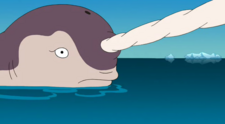Leelu
| Tertiary character | |
| Leelu | |
|---|---|
| Gender | Female |
| Species | Narwhal |
| Planet of origin | Earth |
| First appearance | Bender's Big Score |
| Voiced by | Maurice LaMarche |
Leelu is a narwhal which Philip J. Fry is very fond of as he works with her from 2003 to 2010. She is considered to be rare being that she is a female narwhal with a tusk; this distinguishable feature is much more common to males. Fry tries to catch her from 2010 to 2012, but when he does, he ends up setting her free. Leelu is most obviously an animal representation of Leela, which is also apparent from the name similarities.
Biography
In 2003, Leelu winds up in Atlantic City, but is soon taken to New York. There she won't eat, but as soon as Fry arrives, he gets her to eat and they become the best of friends. But sadly, after seven years of friendship, she must be released into the wild again.
But Fry will not give up, he sets out to catch her. It takes him two years, but finally he manages. But holding her captured for several days makes him realize that she is in love with another narwhal, and it cannot make him happy to watch her wanting to get out. So he decides to release her.
Additional info
Trivia
- The similarities/connection between Leela and Leelu are quite many and obvious.
- Obviously their names.
- It is noted by Fry that he "likes things that have one thing instead of two", due to the fact that there are very few cases of narwhals having two horns, and in the case of females, only one recorded case of a two-horned narwhal, in association to Leela's eye. However, this could be a comparison to most other horned species, which have dual horns.
- As many times as possible, when there is a fade from Leelu to Leela, the horn is placed where Leela's eye is in the following scene.
- Notably, Fry says a lot of the same things to Leelu as he does to Leela.
- Leelu was coloured purple as a reference to Leela's hair, while the male narwhal she is in love with is coloured orange like Fry's hair.
- After the writers did the scene, they realised that it was rare for a female narwhal to have a horn (which is common for the male narwhals), they thus changed the line to introduce her as a "rare" toothed female narwhal.
